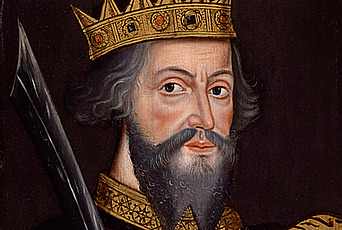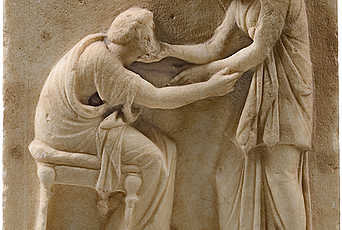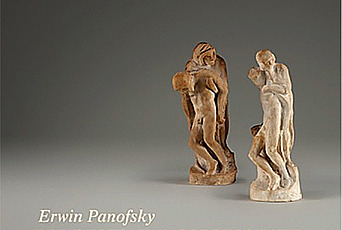Kairos: The Right Moment or Occasion
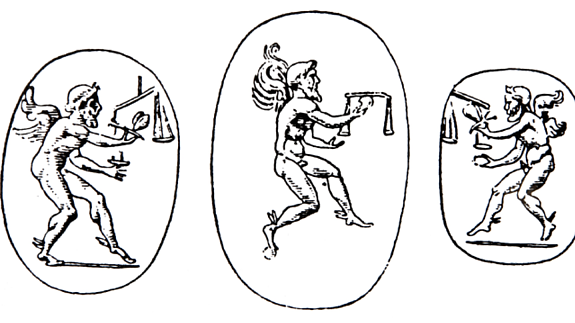
Franz Werfel (1890–1945) ends his novella Pale Blue Ink in a Lady's Hand with the protagonist Leonidas dozing off: “While sleeping under the oppressive dome of the ever-louder music, Leonidas knew with inexpressible clarity that today an offer of salvation had been made to him—dark, muted, vague, like all such offers. He knew that he had missed it. He knew that such an offer would not be made again.”
The ancients had a word for the joy and the sorrow of an opportunity that suddenly presents itself but is just as suddenly gone: kairos. The word goes back to before Homer.
One of the meanings of the Greek kairós is a crucial but vulnerable part of the body. This sense of the word is closely related to the Homeric to kairion: the part of the body can be "hit" to most devastating effect, the place where life is most in danger (Iliad 8.48), or the place where the rock that Hector threw hit Teucros: "just between the shoulder and the neck" (Iliad 8.326). Kairos is the point that makes sacral "passage" possible, the right place, the "target," the place where the knife pierces the skin.
Doro Levi's extensive study shows that the Homeric kairos was part of a group of related words of uncertain origin: kèr: death; keraïzein: to plunder, to slaughter; kèr: heart; kèrainein: to be anxious; kar: lock of hair; keiein: to split; keirein: to cut. All of these related roots have at their kernel the idea of splitting or division, an action of sacrifice in a ritual context.
Gradually kairos came to connote a complex system of signification linking time and space, qualitative and quantitative elements, at a hermeneutic intersection, a knot or node so perfect that it provided the only possible "occasion." The knot is "fit" to intervene, where the moment is "striking." If, however, a single parameter of the intersection were lacking or out of balance, then the knot would unravel and the occasion would not present itself. This is why kairos is also a mirror of cosmic perfection. In the world of Pythagoras, kairos reigns as measure, harmony, and equilibrium. His mystical number is seven, a cyclic "point of crisis." Kairos turns, turns into; he marks the Wendepunkt. Kairos is therefore border, threshold, and limit, as well as transition, change, and progress.

For a long time, kairos had no anthropomorphic form. A Homeric hymn to Hermes has the earliest reference to Kairos as a fair young man and a son of Zeus. Both Hermes and Kairos have winged feet (or even winged shoulders), an epithet that would later be reflected in the iconography, referencing the speed and decisiveness with which both Hermes and Kairos change the elements of the world. Both also carry a weighing scale and/or a razor.
Kairos teaches people to recognize the right moment for quick and calculated action. Late classical texts describe Kairos as bald but for a flowing lock of hair on his forehead: the forelock to be grasped. This provided the subject of Matzke's linguistic study To Take Time by the Forelock. The author investigated the Italian expression tener la fortuna pel ciuffo or pel ciuffetto, alongside the English to take time by the forelock and the Dutch de gelegenheid bij de haren grijpen.
In an epigram, Posidippus of Pella (mid-third century B.C.) described a now-lost bronze sculpture of Kairos by the sculptor Lysippus (last quarter of the fourth century B.C.) in the following terms (in John E. Matzke's translation):
Who, whence is thy maker? Sicyon. His name is what? Lysippus. What art thou? Kairos, the all-subduer. Why doest thou stand on the tips of thy toes? I turn forever. Why hast thou double wings on either foot? I fly carried by the wind. In thy right hand why carriest thou a razor? To men a sign that quicker than any edge I am. But thy hair, why is it over the eye? In order to be grasped, forsooth, by him that meets me. The back of thy head, why is it bald? Because he, whom I have once rushed by with winged feet, will never grasp me afterwards, though he desire it. Why did the artist fashion thee? For thy sake, o stranger, he placed this warning lesson into the doorway.
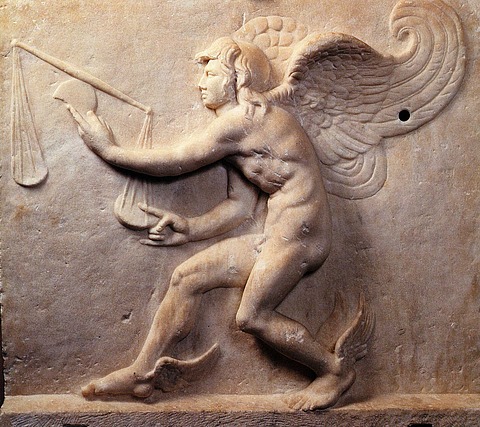
In the first century B.C., Plutarch of Chaeronea wrote in his Moralia: "Beauty is achieved through many numbers coming into congruence [kairos] under some system of proportion and harmony whereas ugliness is immediately ready to spring into being if only one chance element be omitted or added out of place."
Artists saw a particular challenge in the theme. The Kairos figure's afterlife in Western intellectual and art history is not simple, as the transposition of the concept into Latin and the vernaculars also led to iconographic transformations. In the Latin Bible, kairos was consistently translated either as tempus, so losing some of the specificity of its meaning, or was replaced with the concepts occasio and fortuna—both of which, grammatically, change the masculine gender to feminine.
In his Father Time, Erwin Panofsky (1892–1968; IAS Faculty 1935–1968) provided the first study of these semantic and artistic mutations. In his view, from the eleventh century onwards the figure of Kairos cross-fertilized with descriptions and depictions of another concept, namely fortuna. The Carmina Burana (eleventh to twelfth century) indeed sing of Fortuna: "the forehead may have hair, it is true, but it is generally followed by a bald crown." The author sees the classical Kairos, but speaks of Fortuna.
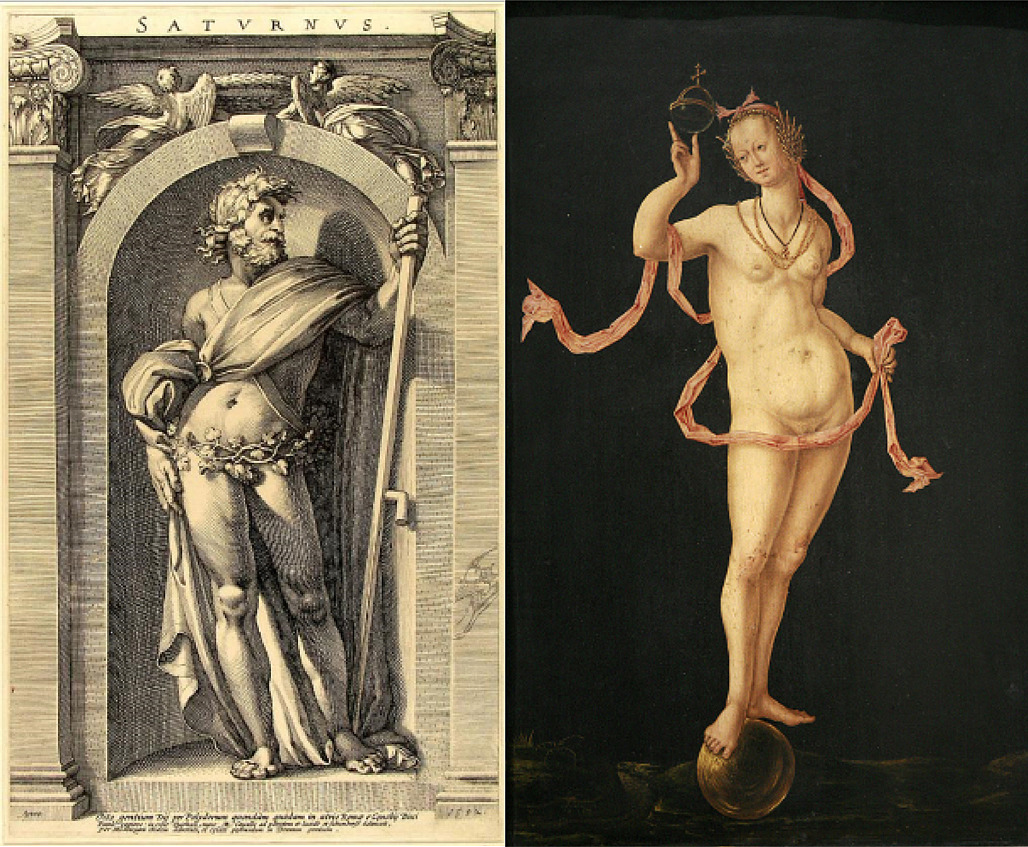
As a result, the Middle Ages and the beginning of modernity saw a range of iconographic ramifications around the concept of time: Fortuna on the wheel, Occasio as a woman on a flying globe, and a bearded, old man as Chronos.
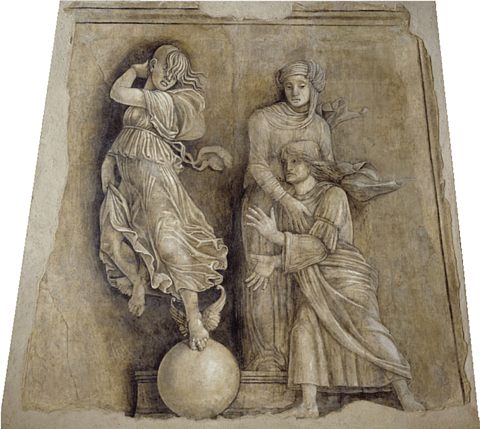
An important aspect of the Christianization of Kairos lies in the preference for a tension between opportunity and penitence. This made Kairos part of a moral discourse, both in a religious context and in the courtly and political world.
The scene in Mantua plays upon this. Just look at the sober woman's marked restraint, the young man's impulsiveness, and the ambivalent way in which Occasio looks back at the boy rather provocatively. The artist interpreted Occasio as a fickle, capricious Fortuna as opposed to the virtue of constancy that keeps the youth from impetuosity in decisions and in life.
The grisaille was described by Mario Equicola (1470–1525), a courtier of the Estes, in a letter written to the Duke of Gonzaga on June 12, 1503. He wrote that the old poets said that fate was a winged woman with hair before her face so that she cannot be recognised and once having passed she cannot be called back.
Dicono li poeti essere una donna alata et tucti li capelli sonno voltati denanti al vulto per non essere cognosciuta et ad ciò fugendo, non possa per capelli essere revocata.
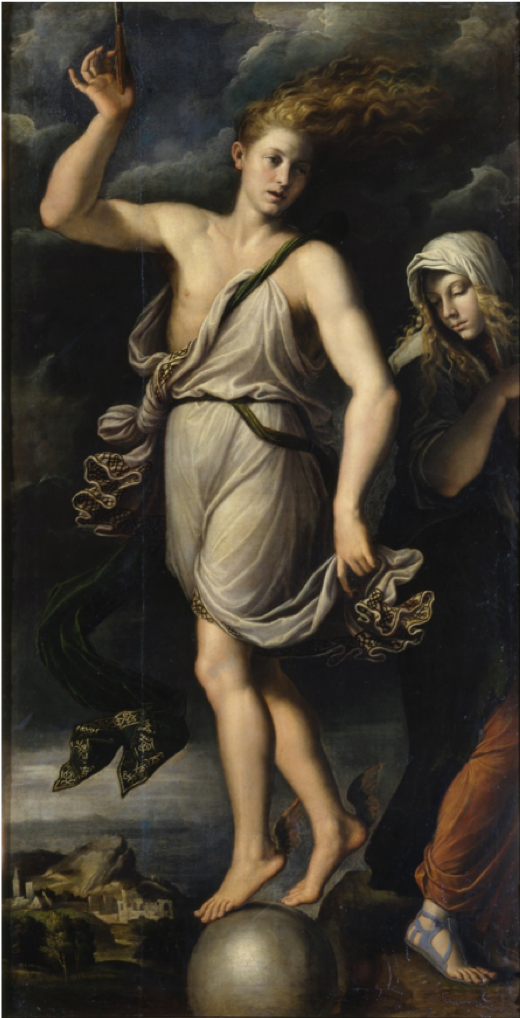
It is generally thought that the painting that Girolamo da Carpi (1501–1556) produced for Ercole II d'Este (1508–1559), Duke of Ferrara, arose in Machiavelli's milieu.
The painting translates the awareness that the prince's dynastic inheritance needs to be "earned" with the virtue of Kairos. This virtù reveals itself in alertness to recognize the moment, then to turn it into political decisiveness and action for a whole community.
To recap:
Both etymologically and metaphorically, Kairos is active in the field of splitting, targets, transition, passage, and entering through an opening. By analogy, Kairos is goal-oriented but ephemeral, sudden but unavoidable. He shares these characteristics with the wind, which can likewise arise out of nothing and die down even faster. His waving forelock suggests he is driven forwards by the wind at his back.
Kairos is kin to angels and spirits as prototypical personifications of the wind. Kairos unites aspects of the wind to human destiny: to the wheel of fortune, the vanes of the mill that has energy and effectiveness thanks to the wind.
There Kairos suddenly appears: in the fleetingness of a sigh, in the quivering of a breeze, in the unexpected movement of a lock of hair. The Greeks put it so beautifully: in the erèmia, the "pregnant pause."
Such as between two notes of music.
Images
Fig. 1 Drawings after Antique games with Kairos, London, British Museum, inv. no. 1199
Fig. 2 Onyx gem, first to second century B.C. with an engraving of Kairos, London, British Museum (previously in the collection of Pierre Louis Jean Casimir de Blacas [1771–1839])
Fig. 3 Kairos relief following the Lysippus model, second century B.C., Turin, Museo di Arte Greco-Romana
Fig. 4 Saturn, engraving, 1592, copied by Hendrick Goltzius (1558–1617) from an original fresco by Polidoro da Caravaggio (1499/1500–ca. 1543), Amsterdam, Rijksmuseum
Fig. 5 Anonymous (Holland), Allegory of Fortune, ca. 1520–1530, Strasbourg, Musée des Beaux-Arts, inv. no. 283
Fig. 6 Milieu of Andrea Mantegna (1431–1506), Grisaille with Occasio, Mantua, Museo della Città nel Palazzo di San Sebastiano
Fig. 7 Girolamo da Carpi (1501–1556), Kairos and Penance, 1541, Dresden, Gemäldegalerie
